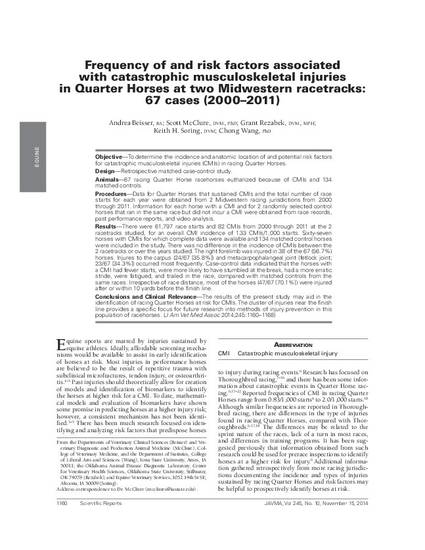
Objective—To determine the incidence and anatomic location of and potential risk factors for catastrophic musculoskeletal injuries (CMIs) in racing Quarter Horses.
Design—Retrospective matched case-control study.
Animals—67 racing Quarter Horse racehorses euthanized because of CMIs and 134 matched controls.
Procedures—Data for Quarter Horses that sustained CMIs and the total number of race starts for each year were obtained from 2 Midwestern racing jurisdictions from 2000 through 2011. Information for each horse with a CMI and for 2 randomly selected control horses that ran in the same race but did not incur a CMI were obtained from race records, past performance reports, and video analysis.
Results—There were 61,797 race starts and 82 CMIs from 2000 through 2011 at the 2 racetracks studied, for an overall CMI incidence of 1.33 CMIs/1,000 starts. Sixty-seven horses with CMIs for which complete data were available and 134 matched control horses were included in the study. There was no difference in the incidence of CMIs between the 2 racetracks or over the years studied. The right forelimb was injured in 38 of the 67 (56.7%) horses. Injures to the carpus (24/67 [35.8%]) and metacarpophalangeal joint (fetlock joint; 23/67 [34.3%]) occurred most frequently. Case-control data indicated that the horses with a CMI had fewer starts, were more likely to have stumbled at the break, had a more erratic stride, were fatigued, and trailed in the race, compared with matched controls from the same races. Irrespective of race distance, most of the horses (47/67 [70.1%]) were injured after or within 10 yards before the finish line.
Conclusions and Clinical Relevance—The results of the present study may aid in the identification of racing Quarter Horses at risk for CMIs. The cluster of injuries near the finish line provides a specific focus for future research into methods of injury prevention in this population of racehorses.
Available at: http://works.bepress.com/chong-wang/78/

This article is from Journal of the American Veterinary Medical Association 245 (2014): 1160, doi: 10.2460/javma.245.10.1160. Posted with permission.